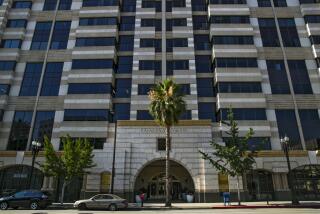THE KEATING INDICMENT : Battler Keating Facing the Fight of His Life : Profile: He’s known for his philanthropy as well as his penuriousness. Now the win-or-else S&L; executive is accused of breaking the rules.
- Share via
Flip Darr figured that he would chalk up an easy win during a round of races at a back-yard pool party in 1973. His opponent was 11 years older, and Darr recalls thinking that “I could beat him, this old duck.”
But the “old duck” was Charles H. Keating Jr., 1946 national collegiate breast stroke champion and a man with an overpowering drive to win. Darr, then barely 40, didn’t stand a chance against his opponent, then 51.
“He cleaned my clock. I was humbled,” said Darr, now coach of the Saddleback College swim and water polo teams. “He’s a great swimmer, a competitor from the word go.”
There is no doubt that Keating is a fighter. And now he faces the biggest fight of his life.
Keating, former chairman of American Continental Corp., the parent of Irvine-based Lincoln Savings & Loan, was jailed Tuesday after a state grand jury returned a 42-count indictment for fraud against him. Three business associates were also indicted and jailed.
Keating has steadfastly denied that he defrauded any securities purchasers, pointing out that the public prospectus accompanying the offering detailed the company’s financial condition and stated flatly that the bonds were not insured. He also asserts that he is not to blame for Lincoln’s failure.
In the past year, through a multitude of public hearings, press interviews and talk-show appearances, Keating has portrayed himself as a victim of incompetent, meddlesome, vindictive government bureaucrats who never understood him or his business.
But the criminal charges, a $1.1-billion civil racketeering suit filed by the government and a slew of other lawsuits paint a portrait of Keating not as a law-abiding attorney and executive but as a sophisticated con artist.
After buying Lincoln in 1984 through American Continental, Keating built the S&L; into one of the nation’s high-flying thrifts. It moved from making traditional home loans to more risky junk bond and real estate investments.
By the time American Continental filed for bankruptcy in 1989 and Lincoln was seized by regulators, Keating had ruffled lots of feathers. And he left thousands of investors angry.
The failure of Lincoln is estimated to cost
$2 billion, making it one of the most costly in the nation’s history.
Despite his reputation as a man who is easy to dislike, Keating--ever quick with a smile or a handshake--can be gregarious and charming.
He is well known for his philanthropy: His companies donated $10.7 million to various charities from 1983 through 1987. Much of the money went to charities run by the Roman Catholic Church.
In business, the Keating management style has been one of benign dictatorship. He paid his employees well and expected them to work hard.
But Keating can also be arrogant and egocentric.
At a hotel he built in Phoenix, the nightclub is called “Charlie’s.” At the Phoenician, a lavish Scottsdale resort he opened two years ago, the nightclub is “Charlie-Charlie’s.”
While battling local politicians in Arizona several years ago, he threatened to move his company and its huge investments from that state for more hospitable quarters in Atlanta.
And commenting last year about whether his political donations influenced the recipients, which include five U.S. senators, Keating said: “I want to say in the most forceful way I can: I certainly hope so.”
The biggest chunk of those contributions went to the five senators who intervened with regulators during an unusually long audit of Lincoln in 1987. In all, Keating, his family, friends, associates and companies gave more than $1.3 million to campaign committees for the senators, including Alan Cranston (D-Calif.), and to causes the politicians supported.
Keating’s activism hasn’t been limited to politics.
A staunch Roman Catholic, he founded a local anti-pornography group in Cincinnati in the 1950s and brought it to Arizona when he moved to Phoenix in 1976.
In Cincinnati, Keating participated in police raids and paid expert witnesses to testify about the harmful effects of pornography. In 1987, after acquiring Lincoln S&L;, he used the thrift to file an unsuccessful suit to shut down an adult theater in Santa Ana, claiming that it was harming business at a nearby Lincoln branch.
His zeal earned him an appointment to the Presidential Commission on Obscenity and Pornography in 1969. But the commission’s 1970 recommendations that adults have legal access to pornographic materials and that sex education become a national goal enraged him. The commission would create “a pagan, animalistic and base” society, said Keating, who successfully sued to get his dissent printed in the official report.
Charles Humphrey Keating Jr. was born in Cincinnati on Dec. 4, 1923, the son of a dairy executive. His father was a victim of degenerative Parkinson’s disease, and his death at an early age instilled in Keating a zest for life and an urgency to get things done.
Keating joined the Navy in 1941, fresh out of high school, and learned to fly fighter planes. He didn’t see combat in World War II but crashed a Hellcat fighter when he forgot to lower the wheels when landing after a night training mission. Recalling the crash a few years ago, Keating said he was concentrating on getting off duty quickly for a date with an attractive woman.
Returning home after the war, Keating
went to the University of Cincinnati, joined the swim team and soon enrolled in the university’s law school. He married the athletic Mary Elaine Fette in 1946, and they have raised a son and five daughters, all swimmers.
In 1953, Keating helped form a Cincinnati law firm, and in 1962 he joined the board of financier Carl Lindner’s American Financial Corp. In 1972, he became AFC’s executive vice president, a post he held until he moved to Phoenix in 1976 to take over an ailing AFC real estate unit called Continental Homes, which he renamed American Continental Corp.
But he quickly ran afoul of federal authorities. In 1979, the Securities and Exchange Commission accused Keating, a former law partner and Lindner of profiting from illegal insider loans while at American Financial. Keating consented to the complaint without admitting any violation of securities laws.
Thousands of people bought American Continental bonds through Lincoln Savings branches in the late 1980s, a nifty piece of salesmanship that netted Keating’s company millions of dollars.
If those investors had known as much about Keating’s 1979 brush with the Securities and Exchange Commission as about his charity, political activism and anti-pornography zeal, they might have kept their money in insured deposits.
Times staff writer John O’Dell in Orange County contributed to this report.
HIGHS AND LOWS OF CHARLES KEATING
1923: Charles H. Keating Jr. is born Dec. 4 in Cincinnati, the first of two sons of a dairy executive.
1941: Joins the Navy and becomes a fighter pilot.
1946: Wins breast stroke competition in National Collegiate Athletic Assn. finals and earns All American swimming honors. Marries Mary Elaine Fette. They eventually raise a son and five daughters.
1948: Graduates from University of Cincinnati Law School.
1953: Forms the law firm of Keating, Muething & Klekamp.
1956: Forms Citizens for Decent Literature, an anti-pornography group which later becomes Citizens for Decency through Law.
1958: Begins handling legal matters for Carl Lindner and his American Financial Corp.
1962: Joins the board of AFC.
1967: Helps his brother, William Keating, a judge, win a seat on city council.
1969: Manages brother’s successful campaign for a seat in the U.S. House of Representatives. Also manages 1972 reelection.
1972: Becomes executive vice president of AFC.
1976: Moves to Phoenix to run AFC’s ailing Continental Homes unit. After the unit is later spun off to shareholders, he takes control and renames it American Continental Corp.
1979: Signs a consent decree on a Securities and Exchange Commission complaint accusing him, Lindner and former law partner Donald P. Klekamp of violating anti-fraud provisions of federal securities laws. The complaint alleged that while at AFC they made $14 million in preferential loans to corporate insiders, including themselves.
1984: Buys Lincoln Savings & Loan with $51 million raised in a junk bond issue by Drexel Burnham Lambert’s Michael Milken. Turns the Irvine thrift away from home lending and into a complex operation based on high-risk land development and trading in junk bonds.
1985: Sells Continental Homes. Testifies in Congress in opposition to limits on thrift investments, marshaling support from economists such as Alan Greenspan, now chairman of the Federal Reserve Board.
1986: Asserts that regulators are harassing him as they launch an audit of Lincoln that ends up lasting two years.
1987: Seeks help to end audit from five U.S. senators. Federal regulators in San Francisco recommend that Lincoln be seized or severely restricted in its operations. Begins sale of American Continental bonds though Lincoln branches.
1988: Washington regulators order a new audit of Lincoln and remove San Francisco examiners from oversight of Lincoln.
1989: American Continental files bankruptcy in April and the next day regulators seize control of Lincoln. He is named in a $1.1-billion civil racketeering lawsuit filed in September by federal regulators. Refuses to testify before the House Banking Committee in November. State and federal grand juries begin criminal investigations.
1990: Federal regulators seek $41 million in restitution for funds they claim Keating diverted from Lincoln. U.S. District Judge Stanley Sporkin rejects Keating’s bid to recover Lincoln, saying that he looted the thrift. A California grand jury indicts Keating on 41 counts of fraud relating to the sale of American Continental bonds.
Source: Los Angeles Times files
More to Read
Go beyond the scoreboard
Get the latest on L.A.'s teams in the daily Sports Report newsletter.
You may occasionally receive promotional content from the Los Angeles Times.










